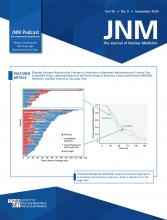Robert Carretta, MD, a past president of both the Society of Nuclear Medicine (SNM; predecessor to SNMMI) and the America College of Nuclear Physicians (ACNP), died on November 1, 2023, in Naples, Florida. Over his long career in private nuclear medicine practice and distinguished service to the profession at the national and international levels, he was widely recognized for his dedication to advancing the field through collaborative efforts.
He was born in 1941 in Philadelphia and graduated from Pennsylvania State University (State College) in 1962. He completed his medical degree in 1966 at the Creighton University School of Medicine (Omaha, NE). Dr. Carretta served in the U.S. Air Force from 1971 to 1977, first at Richards–Gebauer Air Force Base (Kansas City, MO) as chief of cardiology and hospital chief of staff. He accepted an opportunity from the Air Force to undertake a 2-y fellowship in the nuclear medicine program founded only a few years earlier at the University of California–Davis by Gerald L. DeNardo, MD. He then became chief of nuclear medicine at the USAF Wilford Hall Medical Center (San Antonia, TX).
After leaving the Air Force in 1977, he accepted an offer to practice nuclear medicine with Philip Matin, MD, at the Roseville Community Hospital (CA). Over the next 23 years, Dr. Carretta would become a partner in the practice and serve for more than 2 decades as Roseville’s chief of nuclear medicine. Board certified in both cardiology and nuclear medicine, his practice spanned a wide range of early radiopharmaceutical applications, with multiple resulting peer-reviewed publications and presentations at SNM annual meetings. At the same time, he became increasingly interested in the role professional organizations could play in advancing the nuclear medicine specialty. He was active in the Sierra Valley Nuclear Medicine, a regional SNM chapter.
In a 1993 essay looking back on the evolution of private practice in nuclear medicine, Dr. Carretta wrote: “Only by being proactive and able to provide credible clinical information to our referring physicians can nuclear medicine position itself for the next decade” (Semin Nucl Med. 1993;23[1]:46–50). He proposed addressing this goal by encouraging new trainees to enter the field, increasing participation in and collaboration among professional societies, and maintaining engagement with relevant state and federal agencies. He devoted time, effort, and ingenuity to each of these spheres over his more than 3 decades of activity in professional societies. He participated in numerous committees and task forces in both the SNM and ACNP, including those creating widely influential practice guidelines on new techniques and technologies. He served as chair of the SNM Committee on Government Relations in 1995 and 1996, taking the lead in representing the society’s interactions with the Nuclear Regulatory Commission. He also initiated an international outreach program for SNM, in support of which he would travel throughout the world as a lecturer and goodwill ambassador for the specialty. In 1996, as ACNP president, he facilitated the first joint meeting with the SNM.
Dr. Carretta’s presidency of SNM in 1999 and 2000 coincided with the start of the new millennium. He emphasized the importance of expanding multidisciplinary alliances to “allow nuclear medicine physicians to speak with a unified voice when faced with the regulatory and reimbursement issues” that would inevitably increase in complexity (Semin Nucl Med. 2000;30[3]:220–224). He advanced a number of workforce studies for both physicians and technologists, with a particular interest in ensuring that nuclear medicine technologists could advance in numbers and skilled training in tandem with the rapidly expanding field.
In 2000 Dr. Carretta left private practice to become vice president of medical and professional services for the Americas at Nycomed Amersham Imaging (Princeton, NJ), where he was responsible for the company’s product lines, including contrast agents and radiopharmaceuticals. In 2004 he accepted an appointment with Mallinckrodt Pharmaceuticals (St. Louis, MO) as vice president of medical affairs.
Dr. Carretta remained active in organized nuclear medicine activities. He was president of the Education and Research Foundation supporting SNM grants and research in 2005 and 2006. He was among the first group of SNMMI fellows to be inducted in 2016, was a Lifetime Member of the American Board of Nuclear Medicine, a distinguished fellow of the American College of Nuclear Medicine, and a fellow of the New York Academy of Medicine. He retired in 2009. He is survived by his wife, Peggy, and 2 sons, Robert and James.
Leonard Rosenthall, MD, 1928–2024
Leonard Rosenthall, MD, a pioneer in multiple areas of nuclear medicine and a noted educator in the field, died on March 14, 2024. Born in Montréal, Quebec, Canada, in 1928, he completed his undergraduate degree at McGill University (Montréal) in 1949, followed by an MS in 1952 from the University of Minnesota (Minneapolis) and an MD from McGill in 1956. His postgraduate training included internship at Jewish General Hospital (Montréal) and residencies in radiology (University of Chicago Clinics, IL) and radiation therapy (Princess Margaret Hospital/Ontario Cancer Foundation, Toronto, Ontario, Canada). In 1962 he joined the radiology faculty at McGill, where he became a full professor in 1979. In addition, he served as longtime director of nuclear medicine at Montréal General Hospital and director of Lachine General Hospital (Montréal). He formally retired from clinical duties in 2015.
Dr. Rosenthall’s research publications spanned more than 50 years at McGill, with multiple pioneering studies in early radiobiology, innovative tracers, and novel scanning techniques. Very early achievements in renal, cardiac, and brain scanning, as well as in pediatric applications, were notable. His first publication in The Journal of Nuclear Medicine was on a 15-min test of 131I trapping rate in the thyroid (1964;5:657–663). In an article on the history of pediatric nuclear medicine, James J. Conway, MD, wrote, “From 1963 through 1972, new pediatric techniques were introduced…. At the time, many researchers who believed they had developed new techniques had only to search the literature to discover that Rosenthall had done the same thing years before” (J Nucl Med. 2006;47[4]:12N–20N).
- © 2024 by the Society of Nuclear Medicine and Molecular Imaging.









